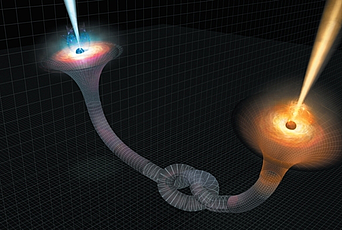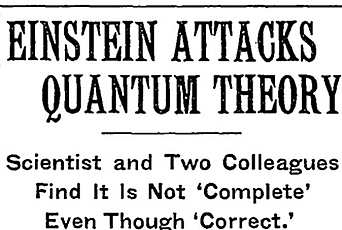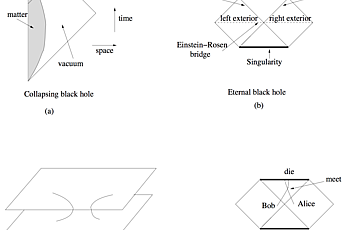Ahmed Almheiri: From the UAE to Firewalls

In 2012, Ahmed Almheiri, current Member in the School of Natural Sciences, coauthored a paper that confounded theoretical physicists, sparked attention from the New York Times to Scientific American, and prompted the organization of workshops and the publication of dozens of papers around the world.
“Black Holes: Complementarity or Firewalls?” by Almheiri, Donald Marolf, Joseph Polchinski, and James Sully (collectively known as AMPS, after their initials) tried to understand how information gets out of a black hole. It was aimed at resolving Stephen Hawking’s black hole information paradox of 1974, which showed that black holes will radiate particles, known as Hawking radiation, as they shrink in size, and eventually evaporate completely. In a quantum mechanical world, particles outside of the horizon of a black hole are mutually entangled with particles inside a black hole, meaning the release of Hawking radiation and the evaporation of the black hole would result in a loss of information. This idea, which has flummoxed physicists for more than forty years, violates the accepted rule of unitarity in quantum mechanics, wherein no information is ever lost and it should be possible to evolve backwards to the origins of a black hole and its constituents.
The confusion and debate underscored by the AMPS paper centers around the idea of quantum entanglement (currently used in quantum computing and cryptography) and how information is entangled inside and outside of a black hole and how or whether it is preserved. Einstein called quantum entanglement “spooky action at a distance” in his description of how two entangled particles mirror each other regardless of the distance separating them. At the heart of the confusion and debate is physicists’ evolving understanding of spacetime and gravity as described by Einstein’s general theory of relativity, which string theorists have long been trying to incorporate into a quantum mechanical explanation of our world. Current thinking suggests that spacetime and gravity are emergent rather than fundamental concepts within a more comprehensive quantum mechanical theory.
The AMPS paper introduced a concept called the black hole firewall paradox, in which the borders or horizons of black holes are not invisible and smooth as conjectured by Einstein’s equivalence principle but rather rife with high-energy particles that would disintegrate a hapless passerby upon contact. The AMPS idea is that the entanglement of infalling and outgoing particles would be broken and the released energy would create a firewall just inside the event horizon.
“The best way to understand something is to first start out confused,” said Almheiri, in a recent interview with the Institute Letter. “The prime example for where there is a lot of confusion is to understand what happens when you add quantum mechanics with gravity in the context of black holes. Stephen Hawking showed that when you do that, you get the information problem. We tried to address that, and we got the firewall paradox.”
If the firewall theory stands, as it has until now, it means that at least one or more of three long-standing concepts in theoretical physics must be wrong: unitarity, Einstein’s equivalence principle (a basic tenet of general relativity, this involves the idea that empty space is the same everywhere, meaning a person falling into a black hole would feel “no drama” when it crossed the horizon), or physicists’ current understanding of quantum field theory.
“It still keeps me up at night,” said Almheiri. “There are questions that need to be answered. For example, if there is a firewall, where is it coming from? What are its microscopics? What is it actually made of? When does it first start to appear? Does it set in at the very early parts of the black hole lifetime? Or does it happen after the black hole has evaporated most of its mass? It’s not clear.”
Almheiri, born and raised in Abu Dhabi, is the first United Arab Emirates (UAE) national—meaning he descends from one of the region’s original families, less than 12 percent of the country’s 9 million-plus population—to become a theoretical physicist and the first to become a Member at the Institute. “After the firewall paper came out, I received emails asking, ‘Are you really from the UAE?’”
Almheiri is the second youngest of nine sisters and three brothers. His mother never received any formal education. His father, who had earned a degree that enabled him to be one of the founders of the Red Crescent humanitarian organization in the UAE and to work as its first Chairman of Board of Directors, is now retired and tends to the family farm. On this land, outside the city’s perimeter, a young Almheiri would look at the stars during late-night family barbecues. “I would be very overwhelmed by the size of it all,” said Almheiri. “No matter where you look, it encompasses you.”
Early on, he was not a high performing student and even failed some of his classes, a pattern that changed when he felt ashamed as an older sister, whom he held in high regard, conveyed the news to his mother. In grade nine, he found that he liked Euclidian geometry, eventually rising to become a group leader in his class. “That’s when I started liking mathematics, because it was very organized, logical, and had definite answers,” said Almheiri. “I like that aspect of it.”
In grade ten, he started taking physics classes. By grade twelve, he was intrigued by special relativity and chemistry. He recalls his chemistry teacher pointing at the table and saying, “In this table, there are atoms, and around these atoms are electrons. But these electrons have a non-zero probability of being on the moon.”
While Almheiri had no idea what his teacher was saying at the time, he was fascinated by the crazy-sounding concept, and when he later studied quantum mechanics, he understood what she meant.
At the end of grade twelve, he read Stephen Hawking’s A Brief History of Time and wanted to understand all of it. “The aspect that I liked about physics and continue to like about physics is that it’s so weird,” said Almheiri. “The concepts become less strange the more you expose yourself to them. The advantage of research is that you keep finding new things to be surprised about.”
It was around this time that he decided that he wanted to become a physicist. But there was no track to becoming one in his country. The UAE was only established in 1971. Almheiri has photographs of his eldest sister as a baby in front of a house made of what looks like palm tree fronds.
“Everyone at the time was expected to be a businessman or an engineer,” said Almheiri. “I remember having discussions with some of my friends, and also family, and I would say I want to be a physicist. And they would reply, what are you going to do with physics? Where are you going to work? There was no place to work as a physicist in the Emirates, at least at the time.”
This meant that Almheiri would have to leave his family and his country, with the desire and intention of returning when his studies were complete. Growing up, Almheiri was fortunate to attend an international private school. In his private school, Almheiri had friends who came from Sudan, Pakistan, Lebanon, and Armenia and who were looking to study abroad. “Mixing with other nationalities was extremely beneficial,” said Almheiri. “At the time, it was not very common for nationals to study abroad with the goal of continuing to a Ph.D. and to do research.”
Along with a few of his friends, Almheiri decided to apply to the University of Toronto. It was 2004 and the continuing tensions that arose after the 9/11 attacks persuaded him not to apply to schools in the United States. At each stage of his education, he was supported by generous scholarships from the UAE government for his undergraduate and graduate degrees, as well as two postdoc positions, one at Stanford University, the second now at the Institute.
At the University of California, Santa Barbara, where Almheiri earned his graduate degree, Polchinski was his adviser. “He is a very good mentor. He is also very, very patient,” said Almheiri. “I’m sure I would have driven any other professor mad.” Almheiri did not like his first few projects with Polchinski, which focused on trying to understand properties of condensed matter systems using the anti-de Sitter/conformal field theory (AdS/CFT) correspondence proposed in 1997 by Juan Maldacena, Carl P. Feinberg Professor in the Institute’s School of Natural Sciences. “I wanted to learn about quantum gravity, not about condensed matter systems,” said Almheiri, “so there was some conflict there.”
Maldacena’s AdS/CFT correspondence describes black holes holographically in terms of a theory living on the boundary of the spacetime. According to this theory, black holes behave like ordinary quantum mechanical objects—information about them is not lost, as previously thought, but retained on their horizons—leading physicists to look at black holes as laboratories for uniting the principles of quantum mechanics and general relativity, two bedrock theories of physics, previously considered incompatible due to the difficulty of incorporating gravity into a quantum world. The AdS/CFT conjecture addresses the incompatibility by equating a theory with gravity (the AdS gravitational system) to a theory without gravity (the CFT quantum field boundary).
The seed of the AMPS paper was planted at a 2012 conference that Almheiri attended at Santa Barbara’s Kavli Institute for Theoretical Physics, “Bits, Branes, and Black Holes,” which involved trying to understand how information is stored in gravitational systems. In addition to looking at Hawking’s black hole information paradox, the conference focused on a concept known as black hole complementarity proposed by Leonard Susskind. Because of something called the no-cloning theorem, Susskind conjectured that there must be a delay between when the information falls into the black hole and when it first appears in the Hawking radiation. “Susskind phrased the question as, ‘If nobody can witness the cloning, then did the cloning actually happen?’” said Almheiri. The AMPS paper started with trying to mesh the concept of complementarity with the quantum mechanical concept of monogamy of entanglement, which requires that a particle cannot be maximally entangled with more than one system.
One of the papers that appeared in response to the AMPS paper was “Cool Horizons for Entangled Black Holes,” published by Maldacena and Susskind in 2013, which proposes that the Hawking information paradox and the firewall paradox could both be resolved if outgoing and infalling particles are connected by wormholes. Often referred to as “ER=EPR,” the paper connects two works that Einstein authored at the Institute in 1935. “ER” refers to a paper written by Einstein and Nathan Rosen (an IAS Member at the time) that suggests that black holes could come in pairs connected by Einstein-Rosen bridges, or wormholes. “EPR” refers to a paper written by Einstein, Boris Podolsky (also a Member at the time), and Rosen, which points out the quantum mechanical property of entanglement. Maldacena and Susskind’s concept proposes that entanglement and wormholes create spacetime, which emerges from connected bits of quantum information.
Maldacena is one of the reasons Almheiri wanted to come to the Institute, along with the opportunity to interact with other Faculty, among them Edward Witten, Nathan Seiberg, and Nima Arkani-Hamed, fellow Members, and the Institute’s storied history. In addition to wanting to understand the physics of the interiors of black holes, Almheiri is interested in developing a better understanding of the AdS/ CFT correspondence, particularly how information about the gravitational theory (AdS) is encoded in the quantum field theory (CFT) and how much and which subregion of AdS can be reconstructed from a subregion of CFT. With former Member Xi Dong and Daniel Harlow, Almheiri authored a 2014 paper, “Bulk Locality and Quantum Error Correction in AdS/CFT,” which suggests the AdS is being coded in the CFT using a quantum error-correcting scheme that distributes the information in a way that protects the quantum system. This may ultimately relate to how stable quantum computers can be protected against errors from the environment, one of the current challenges in successfully building one.
“Where are we now?” Almheiri replied, when asked to reflect on the current state of the black hole information paradox, the firewall paradox, and ER=EPR. “I’d say we are still confused. There is no completely satisfactory resolution. It might mean that we are not asking the right question, and we don’t know what the question is. We make progress in physics when we find the right question to answer.”—Kelly Devine Thomas, Editorial Director


